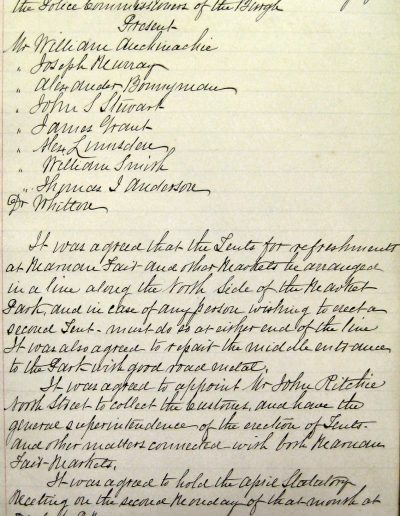Town Council Responsibilities
In the last quarter of the 19th Century all of Britain saw the rise of “municipal socialism”, whereby local authorities provided public services. Reflecting this, the Police Commissioners took on a wide range of powers including paving, cleansing and lighting streets, distributing water and preventing infectious diseases and in 1892 a fire engine was purchased. In the same year the commissioners were retitled councillors, with the chief magistrate – William Auchinachie – now having the title of Provost.
These extracts from the Police Commissioners minute book show examples of what activities they were involved in. At the March 1890 meeting arrangements for the Marnan Fair, held in the Market Park, were decided. At their April 1890 meeting they took over control of street lighting and William Auchinachie set a good example by asking permission to create concrete pavements in front of his properties in the Square:
Members of the Town Council took it in turn to be bailies, who sat in a new Burgh Police Court. Typical business for the bailies, as reported in the Banffshire Journal, would be:
“James M, pedlar, and Peter H, basket maker, were each fined 5s for having been drunk and fighting.” (1894)
“On Wednesday in the Police Court, Agnes McFarlane, a well-known member of the tramp fraternity, was sent for five days to prison for having been drunk and very outrageous in her behaviour.” (1896)
Not all services were under the control of the Town Council. From 1872 elected School Boards ran the schools (apart from the Episcopal School), from 1889 main roads in the burgh (South Street and North Street) were the responsibility of Banffshire County Council, and from 1894 an elected Parish Council was in charge of poor relief.
In 1903 the Town Council took on new powers relating to planning permission and building warrants. It was also now responsible for footpaths and embarked on a campaign to get all existing and new owners to provide a concrete pavement in front of their properties.


